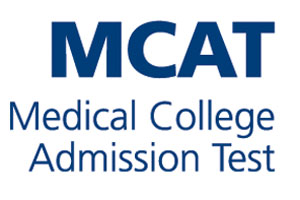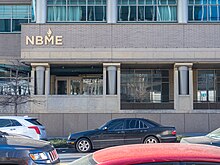
A medical license is an occupational license that permits a person to legally practice medicine. In most countries, a person must have a medical license bestowed either by a specified government-approved professional association or a government agency before they can practice medicine. Licenses are not granted automatically to all people with medical degrees. A medical school graduate must receive a license to practice medicine to legally be called a physician. The process typically requires testing by a medical board. The medical license is the documentation of authority to practice medicine within a certain locality. An active license is also required to practice medicine as an assistant physician, a physician assistant or a clinical officer in jurisdictions with authorizing legislation.
The United States Medical Licensing Examination (USMLE) is a three-step examination program for medical licensure in the United States sponsored by the Federation of State Medical Boards (FSMB) and the National Board of Medical Examiners (NBME). Physicians with a Doctor of Medicine (MD) degree are required to pass the USMLE for medical licensure. However, those with a Doctor of Osteopathic Medicine degree (DO) are required to take the COMLEX-USA (COMLEX) exams.
According to the US Department of Education, the Educational Commission for Foreign Medical Graduates is "the authorized credential evaluation and guidance agency for non-U.S. physicians and graduates of non-U.S. medical schools who seek to practice in the United States or apply for a U.S. medical residency program. It provides comprehensive information and resources on licensure, the U.S. Medical Licensure Examination (USMLE), residencies, and recognition."
Step 2 Clinical Skills of the United States Medical Licensing Examination (USMLE) was an exam administered to medical students/graduates who wish to become licensed physicians in the U.S. It is similar to the COMLEX-USA Level 2-PE exam, taken by osteopathic medical students/graduates who seek licensure as physicians in the U.S. For US medical students, the exam fee is $1,300. For medical students at non-US medical schools, the tests cost is higher—currently $1,535. These fees do not include costs associated with travel and lodging to take the test. Historically, US students have taken Step 2 CS late in their senior year, prior to graduation. However, now that more residency programs require students to record a passing score, many US medical schools recommend students take Step 2 CS in the fall of their senior year.
The United States Medical Licensing Examination (USMLE) Step 1 is a standardized test that assesses a medical student's knowledge of basic science concepts and their application to clinical medicine. The exam is one of three components required for medical licensure in the United States and is typically taken by students after their second year of medical school.
USMLE Step 2 CK is a nine-hour-long exam that represents the second part of the United States Medical Licensure Examination. It assesses clinical knowledge through a traditional, multiple-choice examination divided into eight 60-minute blocks, each containing up to 40 questions, as well as an hour of break time. In contrast to USMLE Step 1, which prioritizes knowledge of basic sciences, the focus of Step 2 is on clinical application of medical knowledge, and requires the examinee to apply medical knowledge, skills, and understanding of clinical science essential for the provision of patient care under supervision. The USMLE Step 2 is generally taken during the third or fourth year of medical school by U.S. medical students. Step 2 results are reported numerically on a scale between 1 and 300; this is in contrast to Step 1, which is pass/fail only.
The Comprehensive Osteopathic Medical Licensing Examination of the United States (COMLEX-USA) is a series of three osteopathic medical licensing examinations administered by the National Board of Osteopathic Medical Examiners (NBOME) similar to the United States Medical Licensing Examination (USMLE). COMLEX-USA is the most common pathway by which osteopathic physicians (D.Os) apply for medical licensure, and is accepted in all 50 states. The 3-digit standard scores of COMLEX-USA Level 1, Level 2- Cognitive Evaluation (CE), and Level 3 have a range of 9-999 and a mean of 500. Most candidates score between 250 and 800. 400 is the minimum passing score for COMLEX-USA Levels 1 and 2; 350 for COMLEX-USA Level 3. It was announced on January 24, 2022 that the COMLEX-USA Level 1 examination will be moving from a 3-digit numeric score to solely pass/fail beginning on May 10, 2022.
In health care, a simulated patient (SP), also known as a standardized patient, sample patient, or patient instructor, is an individual trained to act as a real patient in order to simulate a set of symptoms or problems. Simulated patients have been successfully utilized for education, evaluation of health care professionals, as well as basic, applied, and translational medical research.
An international medical graduate (IMG), earlier known as a foreign medical graduate (FMG), is a physician who has graduated from a medical school outside of the country where he or she intends to practice. The term non-local medical graduate may be similarly used in countries with distinct licensing regions within them. Generally, the medical school of graduation is one listed in the World Directory of Medical Schools (WDOM) as accredited by the Foundation for Advancement of International Medical Education and Research or the World Health Organization.
Most physicians in the United States hold either the Doctor of Medicine degree (MD) or the Doctor of Osteopathic Medicine degree (DO). Institutions awarding the MD are accredited by the Liaison Committee on Medical Education (LCME). Institutions awarding the DO are accredited by the Commission on Osteopathic College Accreditation (COCA). The World Directory of Medical Schools lists both LCME accredited MD programs and COCA accredited DO programs as US medical schools. Foreign-trained osteopaths do not hold DO degrees and are not recognized as physicians in the United States or in other jurisdictions.

Ross University School of Medicine (RUSM) is a private, for-profit medical school. Its main campus is in Barbados, and its administrative offices are in Miramar, Florida. Until 2019, the university's main campus was in Portsmouth, Dominica. RUSM is owned by Adtalem Global Education Inc.
Doctor of Osteopathic Medicine is a medical degree conferred by the 38 osteopathic medical schools in the United States. DO and Doctor of Medicine (MD) degrees are equivalent: a DO graduate may become licensed as a physician or surgeon and thus have full medical and surgical practicing rights in all 50 US states. As of 2021, there were 168,701 osteopathic physicians and medical students in DO programs across the United States. Osteopathic medicine emerged historically from osteopathy, but has become a distinct profession.
The American University of Integrative Sciences (AUIS), is a private for-profit offshore medical school with a single campus located in Barbados. Founded in 1999, it was formerly known as the University of Sint Eustatius School of Medicine (USESOM). For a period, the school was based in Sint Maarten, where it was taken over by IEMR LLC, a US-based company. Since October 2017, AUIS has operated in Barbados, and it is currently a candidate for accreditation by the Caribbean Accreditation Authority for Education in Medicine and other Health Professions (CAAM-HP).
Step 3 is the final exam in the USMLE series of examinations. It is part of the licensing requirements for Doctors of Medicine (M.D.), including international medical graduates aiming to practice medicine in the United States. Generally, it is a pre-requisite of the majority of the state licensing boards.
The Federation of State Medical Boards (FSMB) of the United States is a national non-profit organization that represents the 71 state medical and osteopathic boards of the United States and its territories and co-sponsors the United States Medical Licensing Examination. Medical boards license physicians, investigate complaints, discipline those who violate the law, conduct physician evaluations, and facilitate the rehabilitation of physicians where appropriate. The FSMB's mission calls for "continual improvement in the quality, safety and integrity of health care through the development and promotion of high standards for physician licensure and practice."

The Medical Council of Canada (MCC; French: Conseil médical du Canada, CMC) is an organization charged with the partial assessment and evaluation of medical graduates and physicians through standardized examination. It grants the qualification called Licentiate of the Medical Council of Canada (LMCC), which is a requirement to independently practice medicine in Canada. The MCC's role in physician assessment has been repeatedly criticized as obsolete for several decades.
The United States Medical Licensing Examination score (USMLE score) is given to test takers as a 3-digit score. This score is commonly used by hospitals to determine eligibility for residency and fellowship. The three-digit score is based on a theoretical maximum of 300, but this has not been documented by the NBME / FSMB. Previously, a 2 digit score was also provided, but has since been eliminated. The two-digit score was normalized to the three-digit score such that a 75 was equal to the minimum passing score (currently 194) for the USMLE Step 1. Contrary to popular opinion, the two-digit score does not represent a percentile.

Humayun Javaid Chaudhry, D.O., MACP, FRCP (Lon.), FRCP (Edin.) is an American physician and medical educator who is president and chief executive officer of the Federation of State Medical Boards (FSMB) of the United States, a national non-profit organization founded in 1912 that represents the 70 state medical boards of the United States and its territories and which co-sponsors the United States Medical Licensing Examination (USMLE). From 2007 to 2009, he served as Commissioner of Health Services for Suffolk County, New York, the state's most populous county outside New York City. In 2016, he was listed by Modern Healthcare magazine as one of the 50 Most Influential Physician Executives and Leaders.

Howard S. Barrows was an American physician and medical educator who was Professor Emeritus at the Southern Illinois University School of Medicine where he had previously served as Associate Dean for Educational Affairs and Chair of Medical Education. Trained as a neurologist, Barrows is best known today for his many innovations in medical education, particularly teaching using Problem-Based Learning (PBL), developed while he was a professor at McMaster University Medical School, assessing clinical skills using simulated patients, and studying clinical reasoning using stimulated recall techniques.

The Medical College Admission Test is a computer-based standardized examination for prospective medical students in the United States, Australia, Canada, and the Caribbean Islands. It is designed to assess problem solving, critical thinking, written analysis and knowledge of scientific concepts and principles. Before 2007, the exam was a paper-and-pencil test; since 2007, all administrations of the exam have been computer-based.






